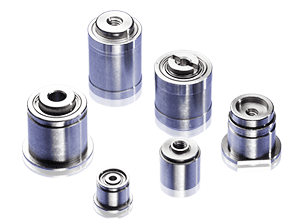Proper handling means keeping the free end of the filament under control at all times when loading and unloading a spool on the printer. When you take a spool off, you must thread the free end of the filament through one of the holes in the flanges, or secure it some other way.
There is also a mechanical aspect to the problem. Specifically, stiff filaments like PLA like to uncoil from the spools and will do so any chance they get, especially when they are fresh and the spool is full. Most spool holder designs will allow the filament to spring over the flanges which easily results in filament tangling and failed prints.
A few months ago I designed a spool holder that prevents the filament from springing over the flanges by pressing rollers against the flanges. The spool rests on two bottom rollers and a third roller, at the top of the spool, moves down and locks in place with the twist of a nut. The rollers turn on F608zz bearings that I had left over from the UMMD build. The rollers are tapered to keep the spool centered in the holder.
Filament spool holder for 3D printer from Mark Rehorst on Vimeo.
I printed and assembled two of the spool holders, one for use on UMMD and one for use on SoM at the makerspace. After using them for a while I discovered two problems. First, filament spool flanges aren't always perfectly round (and neither are 3D printed rollers). I found that adding a couple rubber bands to pull the top roller down against the spool did a better job of keeping the flanges in contact with the rollers and keeping the spool centered.
 |
| Rubber bands were added to both sides to ensure that the top roller stays in contact with the spool flanges. |
The other thing I found was that as simple as it is, my spool holder design was too complicated for some people. I have found the spool holder at the makerspace taken apart on more than one occasion, and a couple times I found a spool mounted on the top roller!
I decided to try to fix that problem. I redesigned the spool holder based on a design I saw on Thingiverse or Youmagine - I can't find the original as there are literally hundreds of design for spool holders on both sites. It has 4 rollers instead of 3 and they're mounted on levers so that the weight of the spool causes all four rollers to press against the flanges, thus preventing the dreaded spring-off and resulting tangles.
The new design uses bearings salvaged from hard disk drives- the same type I used in the 3D printed Van de Graaff generator.
 |
| Head lever bearings from HDDs |
The rollers were printed using single wall vase mode in Slic3r so there would be no seam or little bumps at layer starts/stops. The printer nozzle was 0.6 mm in diameter and the walls are 0.75 mm thick. I printed a test piece to get the right size to be a tight, press-fit on the bearings.
 |
| Test block used to get the hole sizes to press fit on the bearings. Holes vary by 0.1 mm in diameter. |
 |
| One of the rollers in Slic3r. It used single walled vase mode with inner and outer brims to help keep the part stuck to the bed. Each roller took about an hour to print. |
The lever arms are printed ABS and the roller bearings screw into the plastic. The pivot bearings (red) press into the levers.
The base was printed using PLA with 10% infill, 2 perimeters, and 3 top and bottom layers.
 |
| Here's the base printing. It used almost the full width of the bed. |
And now, here's what you've been waiting to see...
If you have a printer with a large enough bed, you can print this spool holder. Here are the design files.
 |
| Fits 200 mm spools... |
 |
| Tapered rollers keep the spool centered. |
 |
| Fits 160 mm spools, too... |



Nice work, thanks for the knowledge. Happy New year.
ReplyDeleteI have a question or plead for help. I am trying to get into 3d print and just purchased 2 working 3D printer (functioning stratasys fdm 2000 printer). Per my quick look on the web, these are old but it comes with a lots of extra. I would like to learn How to run them and, later modify them.
Please could you help
There are some active groups for restoring, hacking, and operating those machines. I suggest you post a message at the RepRap Forums and someone will get you connected to the people who know about them.
Delete